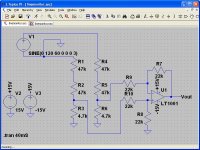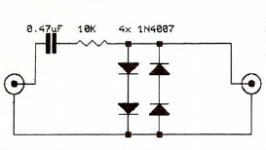The Newegg scope should be fine for isolated line testing and general audio work in low voltage amps.Do not plud the probe directly into the wall outlet. The 400 volt maximum input rating is too low for poking around inside tube amps without a 10:1 voltage divider scope probe.
That is an ideal sine wave. Your power line SHOULD look like this.....it won't. That trace is from a signal generator, or Photoshop.
Where would that wave-form on that display be coming from??
That is an ideal sine wave. Your power line SHOULD look like this.....it won't. That trace is from a signal generator, or Photoshop.
In another forum, Occam wrote:
Powervar acquired OneAC in 2011. I'm not positive, but the PowerVar line viewer appears to be the same as my unit, a OneAC line viewer, model 103. A 103 just sold on EBay for $90 -
OneAC Line Viewer 103 | eBay
The unit outputs common and normal mode noise on 2 different BNCs, as well as the ac waveform on another bnc, hence, the (ideal) requirement for a 2 channel scope for viewing. The input is a standard 15amp IEC inlet.
Powervar PP115 manual -
http://pdf.textfiles.com/manuals/STARINMANUALS/ETA/Manuals/Power Probe.pdf
it matches my OneAC 103 manual, no longer online.
FWIW,
Paul
You can skip the first posts in the thread:
6 Moons reviews - Blue Horizon Mains Noise Analyzer
Powervar acquired OneAC in 2011. I'm not positive, but the PowerVar line viewer appears to be the same as my unit, a OneAC line viewer, model 103. A 103 just sold on EBay for $90 -
OneAC Line Viewer 103 | eBay
The unit outputs common and normal mode noise on 2 different BNCs, as well as the ac waveform on another bnc, hence, the (ideal) requirement for a 2 channel scope for viewing. The input is a standard 15amp IEC inlet.
Powervar PP115 manual -
http://pdf.textfiles.com/manuals/STARINMANUALS/ETA/Manuals/Power Probe.pdf
it matches my OneAC 103 manual, no longer online.
FWIW,
Paul
You can skip the first posts in the thread:
6 Moons reviews - Blue Horizon Mains Noise Analyzer
I think I said it earlier, but the issue with using a transformer to look at the AC waveform is that it will likely scrub all the higher frequency artifacts that are out of the bandwidth of the xfmr... like RFI and anything in the higher ultrasonic range.
I guess that is ok, but a bunch depends on what sort of distortion you want to see.
So, definitely it is ok to start with the output transformer and see what is there, it's somewhat safer since you have a stepdown ratio and lower voltage at the output side.
I guess that is ok, but a bunch depends on what sort of distortion you want to see.
So, definitely it is ok to start with the output transformer and see what is there, it's somewhat safer since you have a stepdown ratio and lower voltage at the output side.
First thing with that jig is to heed the 110 percent thing mentioned earlier. The second thing is those diodes will only convert the line signal into a square wave. Replace the diodes with a 100 ohm resistor and you have a voltage divider as discussed earlier. A quick calculation says the 10k is dissipating 1.4 watts - scale the resistor power rating accordingly.
If it's important to detect DC offset on the line (this would be useful to know - even a little DC can cause transformer saturation and overheating), you should have a direct connection instead of the capacitor.
If it's important to detect DC offset on the line (this would be useful to know - even a little DC can cause transformer saturation and overheating), you should have a direct connection instead of the capacitor.
Last edited:
I tossed together this circuit in LTSpice - it should have the bandwidth of whatever opamp you use. The output is the same whether you ground either side of V1 or leave it floating. All that chances it the currents through R1 and R4. It does pull about 1mA from the line which would presumably go through the ground pin of the oscilloscope or computer's ground connection to the power line, which should be low enough not to trip a GFI.
Of course, remove the .txt extension to load it into LTSpice.

View attachment linemonitor.asc.txt
Of course, remove the .txt extension to load it into LTSpice.

View attachment linemonitor.asc.txt
Last edited:
It is also benefititial to record the mains over a period of time to record brown outs, voltage fluctuations due to loads on your mains etc, and if you are lucky someone near you will be using power line communications, it just adds more noise.
- Status
- Not open for further replies.
- Home
- Design & Build
- Equipment & Tools
- Checking for "dirty" a.c. power with an o-scope
